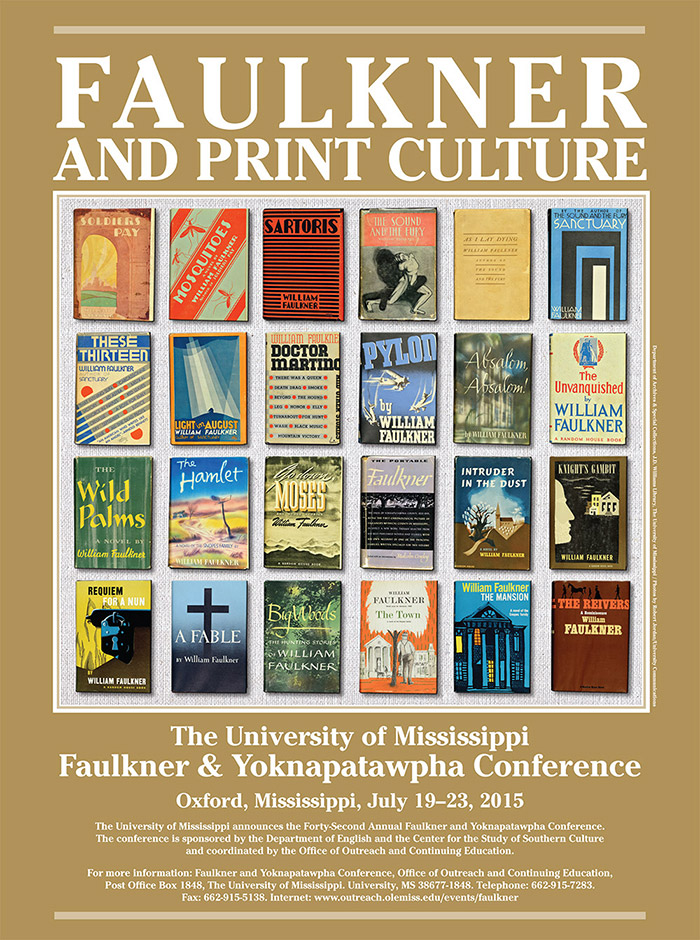
Panel. Composition and Revision
Location
Yerby Auditorium
Start Date
22-7-2015 8:00 AM
Description
- Faulkner's Composition of Intruder in the Dust: From Lucas to Chick and Back to Lucas / Carolina Alvarado, Princeton University
Eight years before he began to write it, Faulkner’s letters refer to Intruder in the Dust as a ”blood-and-thunder mystery” novel, ”original in that the solver is a negro, himself in jail for the murder.” By 1948, the “simple quick 150 page whodunit,” had become a “pretty good study of a 16 year old boy who overnight became a man,” a novel of sociological and psychological depth. The shift in focus from Lucas to Chick evidenced in Faulkner’s drafting process reflects a broader development in his career: a response to the particular expectations created by Malcolm Cowley’s The Portable Faulkner. - An Inside Look at Faulkner's Writing Process: Eleventh-Hour Revisions of A Fable / Christopher Rieger, Southeast Missouri State University
How authoritative are the editions of Faulkner’s novels that we all know? This presentation examines Faulkner’s revisions to A Fable in order to probe this question. Scanned images of hand-written notes from the early stages of composition, drafts of typescript pages with edits and emendations in Faulkner’s hand, and images from the two different “final” sets of galley proofs from the Brodsky Collection will be shown and analyzed to better understand Faulkner’s writing process and how the changes he made to A Fable during the publishing process might affect our understanding of the major characters and themes of the novel.
Relational Format
Conference proceeding
Recommended Citation
Alvarado, Carolina and Rieger, Christopher, "Panel. Composition and Revision" (2015). Faulkner and Yoknapatawpha Conference. 21.
https://egrove.olemiss.edu/fy/2015/schedule/21
COinS
Jul 22nd, 8:00 AM
Panel. Composition and Revision
Yerby Auditorium
- Faulkner's Composition of Intruder in the Dust: From Lucas to Chick and Back to Lucas / Carolina Alvarado, Princeton University
Eight years before he began to write it, Faulkner’s letters refer to Intruder in the Dust as a ”blood-and-thunder mystery” novel, ”original in that the solver is a negro, himself in jail for the murder.” By 1948, the “simple quick 150 page whodunit,” had become a “pretty good study of a 16 year old boy who overnight became a man,” a novel of sociological and psychological depth. The shift in focus from Lucas to Chick evidenced in Faulkner’s drafting process reflects a broader development in his career: a response to the particular expectations created by Malcolm Cowley’s The Portable Faulkner. - An Inside Look at Faulkner's Writing Process: Eleventh-Hour Revisions of A Fable / Christopher Rieger, Southeast Missouri State University
How authoritative are the editions of Faulkner’s novels that we all know? This presentation examines Faulkner’s revisions to A Fable in order to probe this question. Scanned images of hand-written notes from the early stages of composition, drafts of typescript pages with edits and emendations in Faulkner’s hand, and images from the two different “final” sets of galley proofs from the Brodsky Collection will be shown and analyzed to better understand Faulkner’s writing process and how the changes he made to A Fable during the publishing process might affect our understanding of the major characters and themes of the novel.

